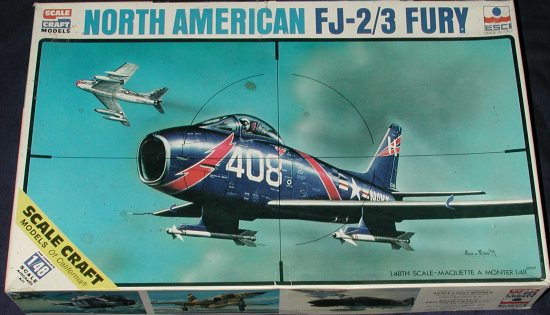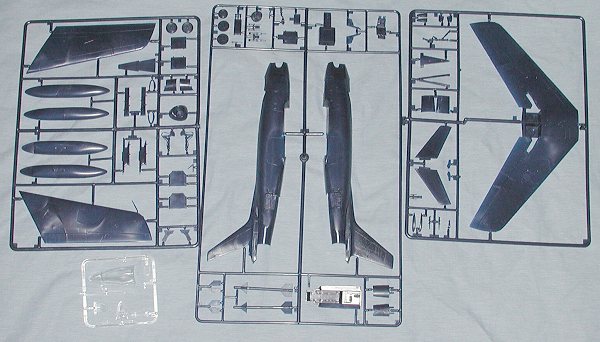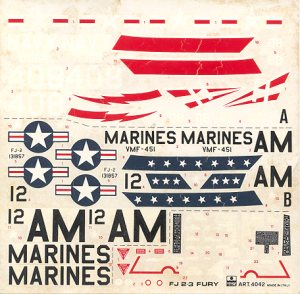
|
KIT: |
ESCI 1/48 FJ-2/3 Fury |
|
KIT # |
4042 |
|
PRICE: |
$ Long out of production (May 2003) |
|
DECALS: |
Two aircraft |
|
REVIEWER: |
|
|
NOTES: |

|
HISTORY |
Navy officials were slow in adopting swept-wing designs for carrier-based fighter aircraft, since carrier operations required lower stalling speeds and better low speed handling characteristics than did land-based operations. For these reasons, the Navy remained with straight-winged fighter aircraft designs long after the USAF had opted for swept-wing designs for their front-line fighter aircraft.
However, the straight winged Grumman F9F Panther and McDonnell F2H Banshee were seventy mph slower than the swept-wing MiG-15, and it soon became apparent that the Navy was going to have to bite the bullet and go with a swept-wing carrier-based fighter if it hoped to be competitive with land-based fighters.
On January 30, 1951, North American initiated the NA-181 project. This called for a navalized version of the swept-wing F-86 Sabre. The Navy showed immediate interest, and NAA issued a formal production proposal on February 6. On February 10, the Navy issued a letter contract for 300 production NA-181 aircraft, with the order being later reduced to 200. The BuAer numbers were 131927/132126. They were to be built in North American's newly-opened Columbus factory, which had also been scheduled to build F-86F Sabres for the Air Force.
The NA-181 was basically a navalized F-86E Sabre and bore very little relation to the earlier straight-winged FJ-1 Fury. One might then have expected the Navy to have designated the new swept-wing aircraft F2J-1, and perhaps even to have given it the name Sea Sabre, following the British tradition. However, the Navy decided instead to assign the designation FJ-2 to the new fighter and to name it Fury, implying that it followed logically from the earlier FJ-1. The reasons may have been more political than technical, the Navy hoping that the Congress would look more kindly on an aircraft which was a "logical extension" of an existing type than to one which was completely new and probably much more likely to cost the taxpayer a ton of money.
Commander Pete Aurand (who was the commanding officer of VF-51, the only squadron to operate the straight-winged FJ-1 Fury) was appointed as the Navy's project director for the FJ-2. He had long been an advocate of the Navy acquiring swept-wing fighters.
On March 8, the Navy ordered three XFJ-2 prototypes. These were all to be built in NAA's Los Angeles factory, since the Columbus plant was not quite yet ready for operations. These were built under the company designation of NA-179, and their Navy BuAer serials were 133754/133756. This was an example of yet another anomalous case in which prototypes were preceded by production aircraft in the numbering sequence.
The first two prototype XFJ-2s (133754 and 133755) were basically navalized F-86E-10 aircraft, equipped with such features as a V-frame arrester hook, catapult points, and a lengthened nosewheel to raise the angle of attack during takeoff and landing. However, they did not have folding wings, and they were both unarmed. They were known as NA-179 by the company.
The third prototype (133756) was armed with four Colt Mk 12 20-mm cannon with 150 RPG. Unlike the USAF, which preferred machine gun armament for its fighters, the Navy had always favored cannon armament for its aircraft. The third XFJ-2 had the usual F-86E nosewheel, and did not have any naval equipment that would enable it to land aboard a carrier. This machine was known as NA-181 on company rolls and as XFJ-2B by the Navy (the B stood for "special armament").
The powerplant for all three prototypes was the J47-GE-13 turbojet, and they all featured the "all-flying tail" of the F-86E-10-NA. All three of them were painted Navy blue, the standard naval paint scheme of the day
Despite its later serial number, the XFJ-2B (133756) was actually the first of the three prototypes to fly, taking off on its maiden flight on December 27, 1951 with test pilot Robert Hoover at the controls. It went out to Inyokern, California for armament tests The first XFJ-2 followed on February 14, 1952, again flown by Bob Hoover.
The three prototypes were accepted by the Navy in June, July, and December of 1952, and in December both XFJ-2s were subjected to carrier qualification tests aboard the USS Coral Sea. The carrier qualification tests did not go very well. The new landing gear and arresting hook bumper were too weak for carrier landings under realistic conditions, and the aircraft handled poorly during carrier approaches and landings.
Although disappointed with the XFJ-2's carrier qualification tests, the Navy was in a hurry to get a swept-winged fighter in service, and decided to begin production of the FJ-2 even before all the bugs were ironed out. The production FJ-2 Fury was to be powered by the General Electric J47-GE-2 engine rated at 6000 lb.s.t.. Since this engine was the Navy version of the J47-GE-27, this brought the FJ-2 up to F-86F standards. The slatted wing of the early F-86F Sabre was used, the "6-3" wing of the later F-86F being deemed to have too great a low-speed handling penalty for safe carrier-based operations. Full naval equipment, including catapult attachment points and arrester gear, was fitted. Wheel track was increased eight inches over the USAF Sabre, and the landing gear was beefed up and made more robust. The FJ-2 had folding wings and was armed with 4 20-mm cannon with 600 rounds. The dihedral of the horizontal tail of the first three prototypes was replaced by a flat horizontal tail. A modified cockpit canopy was introduced. The gunsight was the Mark 16 Model 2, and the AN/APG-30 ranging radar was fitted. The slatted wing of the early F-86F Sabre was used.
Because of North American's commitments to the F-86F program, production of the FJ-2 got under way rather slowly at Columbus. The first FJ-2 (BuNo 131927) was delivered in November of 1952. By the time of the end of the Korean War, only seven FJ-2 aircraft had been delivered. In addition, the end of the Korean War had resulted in the original contract for 300 FJ-2s being cut back to 200. The last of the 200 FJ-2s on the contract was accepted in September 1954.
Initial stability and control tests were carried out with FJ-2 BuNo 131932, which was fitted with a nose boom containing pressure spires and a yaw vane to measure the sideslip angle. This aircraft was redesignated YFJ-2. The YFJ-2 was frequently grounded with various problems during the 1953-54 trials. The YFJ-2 was found to be a stable and efficient gun platform, but only in the hands of an experienced pilot. Ground handling and takeoff characteristics were judged as being satisfactory, but several aspects of longitudinal stability and flight handling were deemed to be problematic. In addition, there was a rather annoying rudder "buzz" during transonic flight.
To compound the problem, a serious competitor to the FJ-2 had appeared in the form of the Grumman F9F-6 Cougar, which had flown for the first time on September 10, 1951. Although slower in level flight than the FJ-2 Fury, the Cougar was considered better at operations from carrier flight decks. Consequently, most of the 200 FJ-2s built went to land-based Marine Corps units, with the F9F-6s going to carrier-based units. Very few FJ-2s ever went to sea.
Marine Corps squadron VMF-122 based at Cherry Point, North Carolina received their first FJ-2s in January 1954. They spent most of their time in land-based operations, but they did go to sea aboard the Coral Sea in 1955. Although most carrier-based naval aircraft at that time were painted blue, these USMC Furies were natural metal. On the Pacific Coast, VMF-235 was the first to receive FJ-2s, which replaced that unit's aging F4U-4 Corsairs. VMF-235 used their Furies in steam catapult tests aboard the USS Hancock, with some 254 launchings of various types of aircraft being made with the ship's new C-11 steam catapults. VMF-235 also flew four FJ-2s retrofitted with stronger tail hook bumpers and modified nose gear struts in an unsuccessful attempt to solve the FJ-2's carrier problems.
FJ-2s served with the VMF-122, -232, and 312 of the Atlantic Fleet Marines, and with VMF-235, -224, and -451. of the Pacific Fleet Marines.
An attempt was made to incorporate the extended "6-3" wing leading edge without slats of the late F-86F on the FJ-2 Fury. The improved high-speed maneuverability that this "6-3" wing offered was an attractive feature, but the increased landing speed and poorer low-speed handing characteristics offered by this wing were definite problems for a carrier-based aircraft. In an attempt to incorporate the "6-3" wing without detracting too much from the low-speed characteristics, the third FJ-2 (BuNo 131929) was modified in August of 1953 with a slatless "6-3" wing having a full-chord wing fence at each butt plane 100. Extended wingtips were also fitted. However, this adaptation caused the aircraft to exhibit an abrupt roll-and-yaw prior to a sudden stall without any warning, which was a most undesirable feature for a carrier-based fighter. In 1954, a thick cambered fence was used with conjunction with another fence near the wingtip. This cured the stall warning problem during the power approach, but stall warning was still unsatisfactory during the final landing approach and a severe yaw occurred during the glide. In October 1954, 131929 was fitted with wing fences covering the leading edge only, at butt planes 100 and 176. This arrangement was more successful, and resulted in adequate stall warnings in most configurations. However, this adaptation was too late to be fitted to production FJ-2s, but was used in the next production version, the FJ-3.
Many thanks to Air-Navy.com for the historical background.|
THE KIT |

First thing you are probably wondering is if this is really an FJ-2. Well, it is as close as you are going to get until someone releases a new kit. The similarities between this and the ESCI F-86 are profound. Basically, this one offers a slightly different canopy, the naval gear (like the arresting hook) and different landing gear as used by the Fury. It also has a four cannon gun panel insert in lieu of the F-86s six machine guns. In all respects, it is pretty much the same kit.
Engraved panel lines, decals for instrument panels, a two piece canopy and provisions for drop tanks and Sidewinder missiles are some of the features. The speed brakes can be displayed open or closed. Now I'm not a Fury expert, but it seems to me that the biggest downfall of this kit is that the fuselage is not deep enough. Looking at photos of the FJ-2 and comparing them to the F-86 will bring this difference to light. The difference is not that great and for most modelers, not enough to warrant any modifications. For others, this can be fixed if the builder is willing to put forth the effort of adding a slice to the fuselage and enlarging the intake to match. As the kit stands, it can only be built as one of the early prototype aircraft, which didn't have the slightly deepened fuselage.
 Instructions are typical of
ESCI and quite good providing a number of photos of the actual aircraft as
well as comprehensive construction procedures. Color information is
provided throughout the sequence and given in what appears to be Humbrol
number (one of the older sequences) as well as FS 595 where applicable and
the usual generic names.
Instructions are typical of
ESCI and quite good providing a number of photos of the actual aircraft as
well as comprehensive construction procedures. Color information is
provided throughout the sequence and given in what appears to be Humbrol
number (one of the older sequences) as well as FS 595 where applicable and
the usual generic names.
As is so often the case with kits bought at swap meets, this one spent too long in a damp basement. As a result, the decals are toast. They've been damp and dry so often that they've started cracking. There are aftermarket sheets by Microscale out there, but they'd be nearly as old. It is too bad as there were two very colorful schemes included with the kit. One is VF-154 from 1955 in glossy sea blue as shown on the box art. The other is a natural metal version from VMF-451 on det at Iwakuni Japan around the same time frame. As with most ESCI decals they are quite matte and well printed. While it may be possible to salvage the instrument panel decals, I fear that the rest are lost.
|
CONCLUSIONS |
Well, here's the quandary. If you want a totally accurate FJ-2 from the box, there isn't one. This one is pretty close and will satisfy most modelers. Others may want to make the mods required for total accuracy. If we are lucky, someone will eventually do a series of Furies at a reasonable price so that this important Naval aircraft can grace our shelves.
Review kit courtesy of me.
If you would like your product reviewed fairly and quickly by a site that has 200,000 visitors a month, please contact me or see other details in the Note to Contributors.